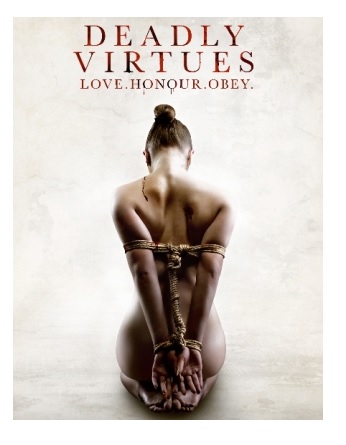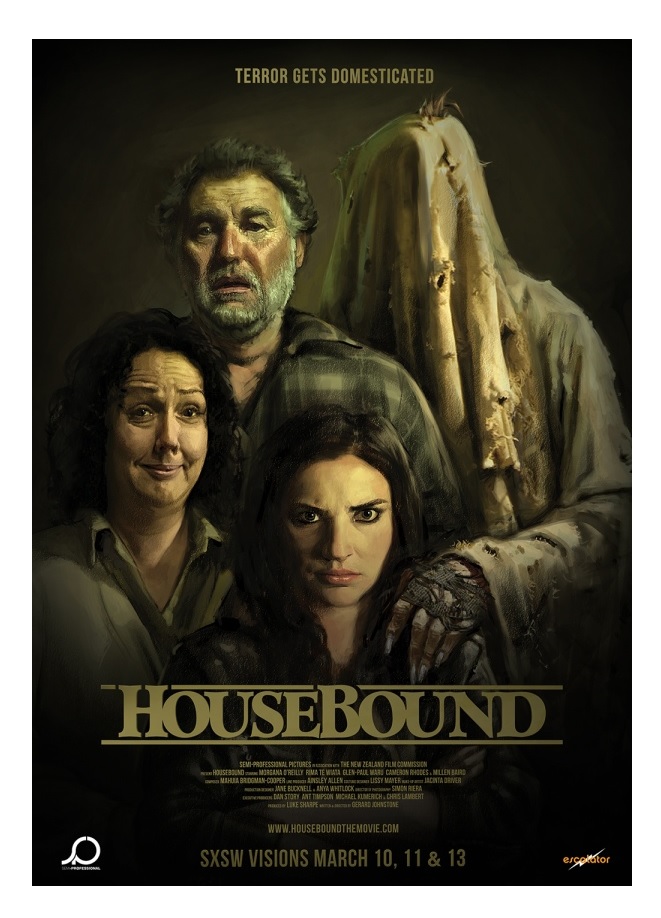
Greetings, all. Ambush Bug here with another AICN HORROR: ZOMBIES & SHARKS column. Dr. Karen Oughton has a gaggle of reviews coming from this year’s Film4 FrightFest which took place last week! Let’s get right to the second and last batch!

DEADLY VIRTUES: LOVE. HONOR. OBEY. (2014)
Review by Dr Karen Oughton (Twitter: @DrKarenOughton)DEADLY VIRTUES: LOVE. HONOR. OBEY. is a horribly and finely nuanced examination of hurt, anger and love hidden in the sheep’s clothing of a home invasion thriller. Be warned that if there is ever a film that should come with a so-called trigger warning, it is this. To say it is fantastic would be to confuse its silences and subdued rhythms with a bombast entirely unlike its tone. Director Ate de Jong’s piece is masterful.
The premise is simple. An obscured man (Edward Akrout) lets himself into a suburban home and makes his way upstairs. Trudging up the carpet, he picks up a stiletto on the staircase and smells it. The camera lingers on the under-toe sole and the overall impression is one of distaste. Not seedy, glamorous distaste, but one filled with the grey sweat of everyday living in little boxes made of ticky tacky (as the song goes). He continues up the beige staircase as we become increasingly aware of the sighs at the top and sure enough inside are a fit, young couple engaging in a bit of light bondage. He enters the room and prepares to join in.
This film is not an easy watch. Indeed, it takes the notion of sadomasochistic role play to an extreme where the dominant partner’s knowledge of both psychology and physiology both confirms and then completely disrupts the idea of consent. The film may gain a backlash for discussing BDSM in this way, but the point of the drama is that our mainstream sexual cultures are based around an almost childlike understanding of sex as a game rather than as the biological response to physical touch. What is more, the depiction and justification of rape culture is part of the story and it is true to the characters rather than being something that should be denied and ignored because it is deeply worrisome and unpleasant. We see the dominant partner’s fingers slip inside the shiny second skin ‘sub’ Ally is wearing while tied to the bed, hear her fitful panting and see her gently tear-stained cheek all the while he discusses how victims often feel pleasure at the time of the crime despite its circumstance. The effect (assuming you’re not squeamish about sadism and masochism) is visually incredibly erotic and at the same time cold and horrifying to hear. An extreme close up on a zipper being take down while the camera pans in unison has the incredible effect of underscoring this in an almost gothic way, with the zip appearing almost alive and creature-like while at the same mechanical, its sound connected to whispers of the girl’s anguished groans. The film is captivating in interrogating the difference between true BDSM relationships, the ‘couple play’ associated with pretty little whips and clean, shiny latex and the misunderstanding of these relationships that formulates psychopathy. By focusing on the subject through the shifting gaze of the players in the context of what is at its basis a simple home invasion thriller, it encourages us to think about the nature of physical and mental consent and how likely we all are to do things against what we understand as our own will.
Just about every aspect of this film is superb. The linchpin is undoubtedly Edward Akrout as Aaron. He combines a sadism that manages to be quite disgusting with a sexiness that relies not so much on charisma (that would be too easy) as on his carefully controlled gestures. This guy is a dominant and not in the ho-hum, suburban sense of the word. Each twitch of his eyebrows and mouth (as accentuated by his moustache) indicates the lining of the mind and body with his espoused philosophy, making it a role to embody rather than simply play. Yet, as the film develops, his performance makes it clear he is not simply a villain, but a dom in what might be considered the truest sense of the word: one who ultimately cares for their submissive, even if his way of demonstrating this is profoundly socially abnormal. He invests a script that could have been played in a number of ways with an incredible pathos.
Megan Maczko is similarly stimulating as Alison. As a presence she matches the film’s tone with perfect poise and a symmetrical face with the parts that are sometimes hidden from view. Her feet are angular and ever so slightly ungainly. Her toenails are perfectly pedicured to highlight the necessity of always appearing at your best, yet the camera focuses on them in close up, making their bonyness ungainly and somehow uncertain as questions of hers and others use of her body arise. Maczko mimics this. She has plenty of very emotional scenes and while she cries, the emotion always feels somewhat deadened. She comes across as someone sleep talking around her existence and is riveting rather than having the awkward, laughable quality stilted drama often evokes. You feel for her because you cannot feel with her because she does not truly feel herself.
The most contentious performance is that of Matt Barber as Tom. At times his anger feels slightly less authentic, but then home invasion thrillers fabricate an incredibly rare and extreme occurrence while unpleasant people are depressingly common. Lines such as “I can’t stand anyone else inside you” can therefore demonstrate a depth of devotion, a threat or both. To understand how and why such people exist, one only has to look to the reactions of the supporting players who let it happen. It is stunning to think this comes from the director of Phoebe Cates’ family film, DROP DEAD FRED.
Stylistically, far from being a fast and shouty film, the score is phenomenally important here. Listless piano and cymbals play as Aaron wonders how to get the girl to love him. It’s like a corruption of a romantic arthouse movie and the camera switches to Aaron’s point of view as he watches a home video of the couple engaging in some light role play, only for the camera to tilt away when the scene develops into something that refutes their clean, polite and ordered lifestyle. Indeed, barring the ending covering the closing credits (which does come across as rather out of context), it is as much a soundscape as a visual representation. This is down to the whispered words that are only just audible on the soundtrack, ensuring you’re never quite sure what you think you’ve heard.
DEADLY VIRTUES: LOVE. HONOR. OBEY. is not a film for everyone. It is extremely hard to watch in places and the politically correct lobby with undoubtedly be horrified by some of it, but that is the point. The film’s intention is to use a cheap genre staple to show how we allow ourselves to become party to violence. Without this we are left thinking cruelty is something that walks on by outside of our curtains rather than something we may unwittingly lust after inside. It illustrates, with cruel complexity, the emotional ties that truly bind.

ALLELUIA (2014)
Review by Dr Karen Oughton (Twitter: @DrKarenOughton)She works in a morgue, has a young child and has long since forgotten that she also has a vulva. Pressured by a friend, she agrees to meet Him. He is suave, his language sexual and he makes snippy, Sherlockian comments about their fellow diners’ shoes. He is both creepy and enticing. They take their leave, have fantastic sex and he sniffs her stilettos while she purrs from tip to toe. They come to an ‘arrangement’ and then the murders start. Fabrice du Welz’s film, loosely based on the real-life case of the so-called Lonely Hearts Killers, mixes great performances and daring camera work to come up with a film that comes across as frankly, well, bonkers.
It is entirely true that ALLELUIA gives an expressionistic account of falling maddeningly in love. From the first few minutes of the film, the camera takes on red tints to show us just how much joy Gloria (Lola Duenas) gets from rediscovering her own body. We even get what appear to be fantasy sequences in which the couple dance around a fire in a sort of pagan rite and it’s certainly atmospheric. The performances, too, are extremely good, with Duenas convincing as a woman whose libido causes her to lose control over her senses, while Laurent Lucas (as Michel) has an easy charm and the good looks to ensure that you can believe women would fall at his feet in less than normal circumstances.
The problem with the story is that these women do fall at his feet over and over again, courtesy of Gloria. Their arrangement (aided by a strangely accurate piece of ritual magic) is for Michel to cast a love spell (yes, a love spell) on loaded local ladies, sleep with them, steal their money and run… while they pose as a particularly close brother and sister… using their real names. Despite the fact that they never follow the plan through because Gloria gets so jealous she keeps accidentally offing the anticipated conquests. We have everything from oral sex going spectacularly wrong to a random section where a suspiciously sexy priest disappears to get an unexplained envelope, never to return, while Gloria inexplicably collapses into gales of laughter. This is after she has casually run away to her highwaywoman’s lifestyle having dropped her daughter off at a friend’s house apparently for an afternoon, going against her every character trait previously suggested. Each conquest, she screams and kills in a flail of hair and windmilling arms while he stands looking mildly surprised and oddly gormless. Their actions make no logical sense over the extended time period in which the film is set as they’re both intelligent people.
Everything about the film is bizarrely reminiscent of much-mourned melodrama series Sunset Beach, in its total dramatic commitment and utter derangement, because literally nothing in it makes the blindest bit of bloody sense! It’s peculiar because de Welz stated in the FrightFest Q&A that every single shot was planned and he shot on 16mm because he wanted to make the film ‘properly’. Despite this, his pursuit of self-consciously high art ends up as something it’d be ideal to watch on a Saturday night when your brain can take little more than low grade beer, cheesy nachos and a Lolcats encore.
ALLELUIA manages the perverse achievement of taking the classical elements of superb film making and turning them into something so strange as to be unintentionally hilarious one moment and boggling the next. It was crafted with love, yet the true love on which it is based appears all the more fictitious for it. Crazy in love? ALLELUIA’s crazy right now.

HOUSEBOUND (2014)
Review by Dr Karen Oughton (Twitter: @DrKarenOughton)Sometimes there comes a film so determined to follow its own weird path that it winds up really quirky and might confuse its audiences as a result. This is the case for the well intentioned, oddly daring and pleasantly entertaining New Zealand film HOUSEBOUND. Directed by Gerard Johnstone, the premise sees Morgana O’Reilly as ATM robber Kylie, who is placed under house arrest when a job blows up in her face. She’s sent back to live with her mother Miriam, a huge character with an animated face and an even more animated mouth, who is convinced that their home is haunted.
HOUSEBOUND has the potential to appeal to a variety of different audiences though it is often neither fish nor fowl. At times it plays purely as a comedy focusing on Miriam’s maddening merriness in contrast to Kylie’s almost cartoonish emo and it has some brilliant deadpan humor. That said, it is also at times genuinely unnerving and delivers a few fun jump scares. Its main bonus, though, is how it keeps changing. It veers from silly spook caper one moment to an indictment of support services the next without ever becoming hectoring. This actually makes it a really fun watch and it’s impressive that the evolving tone never feels forced as opposed to organic and bizarrely believable.
The acting is in large part responsible for this. O’Reilly convinces as both as the sullen crook and later as the person whose reaction to her circumstances helps her to discover the resolve she didn’t realize she had. A sequence in which she finds some of her old childhood possessions may be slight, but it’s extremely well played and fleshes out her character wonderfully. Rima Te Waita (as mother Miriam) is similarly solid. Much has been made of her comic timing, but the truth is she is also at the film’s emotional core as her silences express what she can’t bring herself to say. Her eyes show someone who has made ‘making the best of it’ a motto to help her to live through the strangest unpleasantness.
Oddly, the direction is one area that is a little disjointed. In the latter half of the film while the storyline and actors convince, the characters become just a little too outlandish. This is exacerbated by props and costumes that come close to destroying the very realism that piece has (in an admittedly strange way) built up, with mad hair being a particularly clunky device to show character development in a way that would probably patronize a ten year old. In the end, the film gets away with it because of the script and actors (especially Ryan Lampp), but it is a close-run thing.
HOUSEBOUND is an inventive haunted house caper-come-whodunit that generates a huge amount of good will owing to the acting and commitment to its own idiosyncratic story. It is creepy in some places and wildly funny in others as well as being oddly believable. It may not be the funniest or scariest comedy horror of the moment, but it is hugely ambitious and should leave you in high spirits regardless.

THE BABADOOK (2014)
Review by Dr Karen Oughton (Twitter: @DrKarenOughton)“If it’s in a word, or it’s in a look, you can’t get rid of The Babadook” is the phrase that haunts Amelia as she tries to lull her terrifying son to sleep. On the face of it, THE BABADOOK is a SINISTER-esque story with a few really great jump scares and an interesting looking beastie. In reality, it’s a study of the maddening power of grief and if there’s any damn justice it should win Essie Davis a Best Actress Academy Award for her physical performance, let alone her extraordinary emotion.
Davis’s Amelia is not in a great place. She’s still utterly bereft following the grisly death of her husband seven years before in a road accident, she has a job that doesn’t utilize her talents… and she has Samuel. Samuel (Noah Wiseman) is her son and has what is politely described as behavioral problems. He is physically aggressive, finds it impossible to make friends and is becoming prone to fits in which his entire face is swallowed by his gaping red gash of a mouth. He is absolutely convinced a monster, named in a mysterious story book, is going to get them and he won’t sleep. Amelia is therefore similarly deprived and gets more and more unhinged as a result.
Photography in the film plays like a recurrent sleep paralysis, repeating over and over again with wearied knowing and resignation that the fear will happen and will be vile even though you know what’s coming. What’s more, Jennifer Kent’s direction is superb and forces you to agree to be dominated by the monster even though it is as childlike as it is dreamlike. We move from Amelia trapped in her helter skelter memories and are flung with her from one scene to the next by jump cuts and point of view shots that show how her exhaustion begins to separate her from the real world by inoculating her against its surprise. That said, the photography also has a good grasp of incorporating other styles to retain the social conventions she struggles to abide by, with one of the few moments of outright comedy coming straight out of THE STEPFORD WIVES. Moments of normalcy are captured with a low key realism that ensures you still care about the characters regardless of how bad their behavior becomes.
Essie Davis manages to remain believable whether she is conveying her simple tiredness or is screaming the world away. Her physical performance couldn’t have been more removed from the mousey woman who stood on the stage at the FrightFest screening, asking the audience for their consideration. She kicks THE EXORCIST’s Regan into a cocked hat apparently without a gallon of prosthetics. Even in the sections that are arguably too far-fetched and threaten to break the film’s believability she retains an authenticity owing to the fact that it seems Amelia herself is performing. Huge credit must also go to Wiseman as her son. He matches her (adult) skills with admirable nuance while also being surprisingly good at naturalistic acting, his lighter sections coming off as simply joyful. You will understand Amelia’s perspective because by the end you will have wanted to throttle and adopt the little bugger.
Whether or not you’ll like THE BABADOOK comes down to what you want from the film. It is terrifically creepy in places but it does not wish simply to scare, which may neutralize the blind terror it generates for some people. Instead, it is a film about what comes after fear: sapping resignation and, possibly, determination to keep going. Thanks to the cinematography, direction and the acting, it will speak to you. Fear is in a word and in a look as you can lose yourself to THE BABADOOK.
